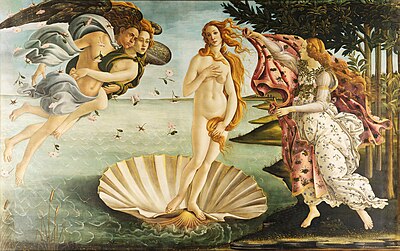Sandro Botticelli, Birth of Venus, c. 1484-86,
Sandro Botticelli's "Birth of Venus" is an iconic piece of art from the Renaissance time period that is based on Homer, a poet who wrote about Venus who is the Roman goddess of sex, desire, and beauty. The painting depicts Venus arriving to a shore on a shell completely nude. Three other figures appear in the piece as well one being Zephyrus who helped Venus find her way to the shore, Another figure appears to the right of Venus, and is known as the "Goddess of spring" who seems to be waiting for her on land. The painting represents the emergence of Venus to the world.
One being Zephyrus who helped Venus find her way to the shore using wind.
This painting also represents the beauty standards of the time. She is seen to have light skin and a smooth, unblemished skin which represents purity and innocence. She also has extremely long hair that is also slightly covering her naked body. Although, Venus was the Goddess of sex, she looks vulnerable because she covers her private areas. However, this painting is still extremely sexual and men would typically be the ones viewing this, also known as the "male gaze". Venus is the ideal woman (beauty wise) and expresses how women were viewed at that time. It also shows that Renaissance art was not only religious but there were others themes as well in this case ancient Roman mythology and also sex.

No comments:
Post a Comment